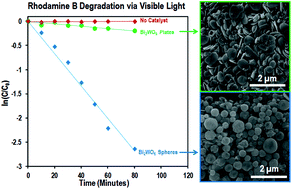Polycrystalline microspheres and single-crystalline microplates of Bi2WO6 have been synthesized by ultrasonic spray pyrolysis. Herein, these materials are evaluated as photocatalysts for the visible light mediated degradation of rhodamine B, a model pollutant, and the results compared to those obtained with Bi2WO6 prepared by traditional methods. The microplates, which displayed the best crystallinity and highest surface area, were anticipated to facilitate the greatest rate of dye photodegradation. However, the polycrystalline microspheres outperformed both the Bi2WO6 microplates and traditional samples. To understand the origin of this result, the local and macroscale structures of the Bi2WO6 samples were comprehensively characterized by spectroscopy techniques (diffuse reflectance, fluorescence, Raman, and X-ray photoelectron spectroscopy) as well as electron microscopy and diffraction. This analysis found that the enhanced performance of the Bi2WO6 microspheres results from the expression of a hydrophilic surface, a low concentration of point defects, and a moderate surface area. This finding highlights the significant role synthesis plays in imparting structure and functionality to solid materials.

You have access to this article
 Please wait while we load your content...
Something went wrong. Try again?
Please wait while we load your content...
Something went wrong. Try again?


 Please wait while we load your content...
Please wait while we load your content...